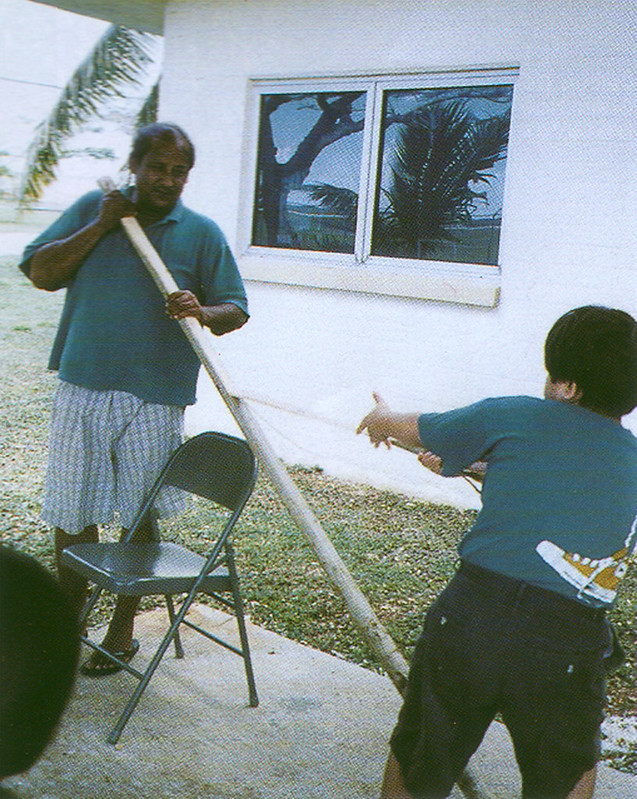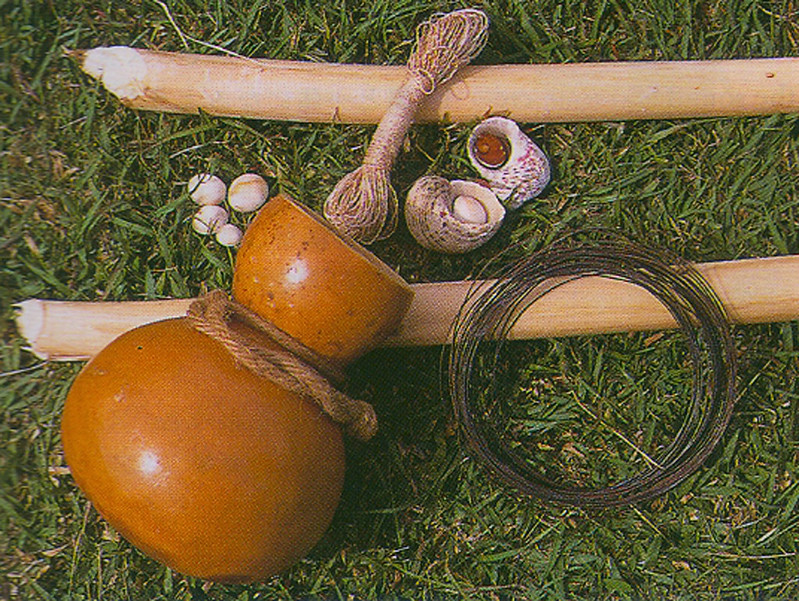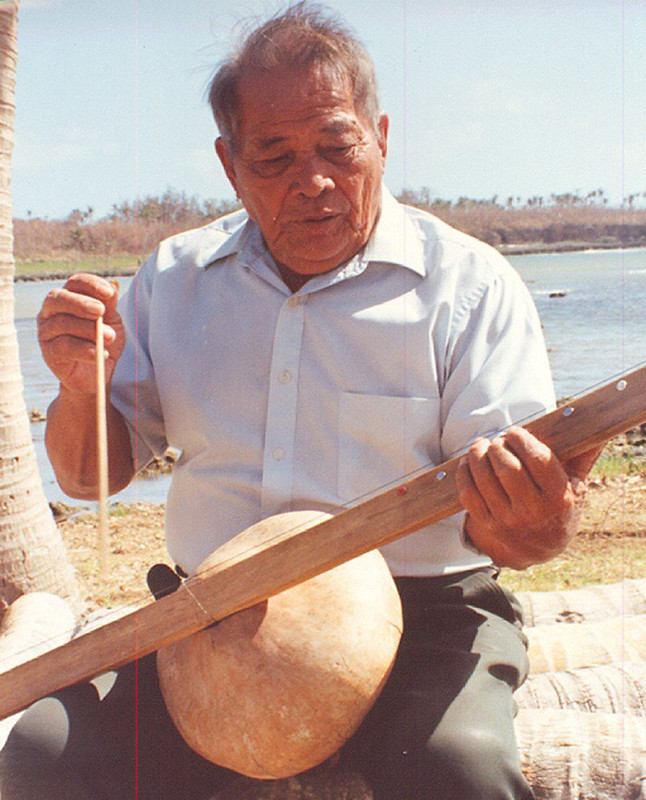Belembaotuyan
Single-stringed instrument
The belembaotuyan is a long single-stringed musical instrument historically found on Guam. It is classified as a stick zither, which is an instrument with no neck or yoke. The string is stretched between the two ends of the body and has an attached resonator.
The belembaotuyan consists of a long flat stick with one string that is almost equal to the length of the stick with a resonating gourd. The string is attached to each end of the long board. Soft wire or sturdy string is used to hold the gourd in place as well as divide the sound of the string into high and low. The gourd is positioned where the sound divides near the center. Moon shaped seashells are used at each end of the instrument to help give the string a clearer sound. Aluminum pieces are used at each end to keep the string from cutting into the wood.
The belembaotuyan used to be heard during weddings or other special occasions on Guam. More recently it has become part of Chamorro Month celebrations at Guam’s schools. Today it is heard rarely as only a few people know how to play or construct the ancient instrument.
The meaning of belembao in Chamorro means “swaying of the trees” and tuyan means “stomach.” Essentially, belembaotuyan means either a “one-stringed belly echo” or “vibrations of the belly.” The gourd resonates with the help of the stomach cavity and the player can create a vibrato by moving the gourd back and forth off the stomach.
The instrument was, at times, historically spelled belumbaotuyan, belenbaotuchan, and belimbau-tuyan.
The instrument may share roots with Brazilian instrument called the berimbau. Because of shipping and constant trade between Asia and South America, a belembaotuyan player most likely stopped on Guam and introduced the instrument to the Chamorro people more than 150 years ago.
Origin theories
There is a Brazilian instrument called the berimbau, described as a five-foot pole with a metal wire strung on it like a bow and a gourd attached about a fourth of the way to the top. It was played alongside other Brazilian instruments in a ceremony called Macumba, which originated in Africa.
Brazil, Africa, and Portugal all have cities named Belem, which are all near a body of water. Belem, Brazil can be found at the mouth of the Amazon River. Belem in Mozambique, Africa, can be found near the Indian Ocean and Belem in Portugal is found near the Atlantic Ocean.
It is possible that African slaves from Mozambique with knowledge of the instrument were transported to Portugal, which has been greatly influenced by African culture. The knowledge moved along with the people from Portugal to Brazil.
Making a belembaotuyan
The length of the stick or the size of the gourd on a Chamorro belembaotuyan may vary. The dimensions of the belembaotuyan stick can be between four and nine feet long.
The tools needed to make a belembaotuyan are a machete, a saw, and a knife. Because heavy wire was hard to come by on Guam in the past, belembaotuyan makers took wire from radial tires. The rubber was cut until the wire was visible and then the rubber was sliced away from the wire.
The wood or stick comes from the banalu tree (Pacific Rosewood or Thespisia populnea) or the pago tree (hibiscus tree or Hibiscus tiliaceus). Both trees, which look alike, can be found in the jungles of Guam almost anywhere on the island. It is best to use the young tree because it is more flexible and easy to bend. The tree should be cut 6 to 7 1/2 feet long, skinned with the machete, and then split in half or chipped carefully with the machete. A narrow stick does not make as much sound as a wider stick.
The gourd used for the belembaotuyan is grown mainly for the medicinal value of the leaves and is not edible. Coconut shells and gourds (tagua) can be used as resonators but each produces a different sound. The coconut shell is much smaller, harder, and can easily crack. Although constructing the resonator from coconut shell may be a fairly simple process, it yields less resonance. The gourd is preferred because of its various shapes and sizes. The larger the tagua, the more the sound will resonate.
The cat’s eye shell or moon shell (operculum), which is used at each end of the instrument, can be found on the beaches or in the ocean.
Aluminum strips or pieces of a tinplate are used to reinforce each end of the stick in order to prevent the wire from cutting into the wood.
The bridge in the middle of the belembaotuyan is made of soft wire or sturdy string, and is used to hold the gourd in place and to divide the sounding pitches of the instrument into high and low.
The hitting stick, or the plectrum, is made out of bamboo. The stick must be thin and about a foot long.
To assemble a belembaotuyan split the wood in half lengthwise and skin it with the machete. Place a nail or a screw at each end of the stick to wind the wire around. Before the wire is placed on the stick, place the aluminum plate strips at each end during the placement of the wire. The wire is placed on the stick the same as a string on a bow, but not too tightly. Allow the stick to dry for a day or two. After the stick dries place the cat’s eye shell or at each end of the stick.
Next, take a gourd, saw it in half to obtain two bowl shapes. Clean the gourd out and then cut a hole at the top of each half and rest one half of the gourd inside the other. Place these rested gourds under the board. Get a short stick, or a small jar lid to hold the soft wire in place. This forms the bridge, and also joins the two gourd halves.
Adjusting the bridge is probably the difficult part because you have to know where the sound divides. The lowest tone is usually found on the right side of the belembaotuyan string while the left side is four tones higher. The string should sound the dominant tone (V, Sol) on the right, while the left half of the string sounds the tonic tone (I, Do).
Materials used to make the instrument have changed over the years because of access and availability. For example, the string used on the instrument today differs greatly from the wild pineapple fiber that was available in the past. The string made out of fiber produced a softer and quieter sound. Wire, as found in radial tires, produces a brighter, louder, and more vigorous sound.
Playing a belembaotuyan
When tuning the belembaotuyan, the gourd is carefully moved off center in order to get the right division of sound from the wire. The bridge and the gourd will not be exactly dead center. In fact, the left half of the string will be somewhat shorter. If the bridge gets loosened from the gourd you can turn the gourd in order to tighten and give the instrument a much clearer sound.
Originally, the performing position was a reclining position. Today, however, the belembaotuyan is usually played in a seated position, the gourd resonator resting against the abdomen.
The stick is held between the thumb and the index finger. The middle finger bounces the plectrum on the wire string, while the remaining fingers are curled and relaxed. Students practice holding the hitting stick and making it bounce naturally.
In holding the instrument, the fingers of the left hand are placed under the string and moved up and down to obtain different pitches. The left hand does not press down on the string as in guitar playing, but rather the first joint of each finger lightly pushes up the string. The right hand holds the hitting stick and plays the tune by letting the stick bounce from one side to the other, over the bridge. The rhythm of the right hand is the actual tune of the songs being played.
Left-handed players can play this instrument too because there is only one string to play. The process is simply reversed, thus the right hand presses under the string while the left hand bounces the hitting stick.
The solo pieces played on the belembaotuyan have dynamics that are neither soft nor loud but moderate. Dynamic expression is not an important feature of belembaotuyan music. The meter of the pieces are usually duple (2/4) or (4/4). The rhythm of the plectrum is usually that of the melody. Pieces played on the belembaotuyan are usually moderate in tempo.
The belembaotuyan can be accompanied by a guitar tuned to it. There is no music written specifically for the belembaotuyan and much of the repertoire is based on song melodies.
By Therese Q. Crisostomo Pangelinan
Videos
For further reading
Babauta, Shannon. “Belembautuyan Still Treasured.” Pacific Daily News, 10 February 1983.
Baines, Anthony, ed. Musical Instruments Through the Ages. Baltimore: Penguin Books Ltd., 1961.
“Belembautuyan.” Guam Recorder, (January 1934).
Belenbaotuyan – Direct Wire to the Past. Nieves M. Flores Memorial Library file. NA: 1967.
“Belumbaotuyan Brings Security Benefits.” Guam Times Weekly, 11 September 1965.
Handler, Elaine. “Faith and Frenzy”. Maryknoll, (January 1972).
Higgins, Margaret M. “Guam – Perch of the China Clippers.” National Geographic Magazine 74, no. 1 (July 1938): 99-122.
“Music Week.” Guam Recorder 6, no. 2 (May 1929): 23, 33.
To Entertain. Nieves M. Flores Memorial Library file. NA: 1960-1965.















